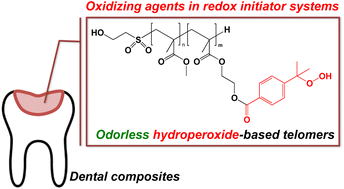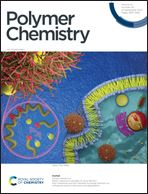Synthesis of original polymeric hydroperoxides as innovative oxidizing agents for self-cure dental materials†
Abstract
Redox initiator systems based on cumene hydroperoxide are currently widely used for the curing of self-cure (SC) and dual-cure (DC) dental materials. Unfortunately, cumene hydroperoxide exhibits a strong odor, which can be unpleasant if high amounts of materials are required for a restoration. In order to reduce smell, innovative cumyl hydroperoxide containing oligomers were prepared and tested as oxidizing agents in current self-curing dental formulations. In a first step, a methacrylate monomer containing a cumyl group was synthesized, namely the (4-isopropylbenzoate) 2-ethyl methacrylate (IBEMA). Then, homopolymer from IBEMA (PIBEMA) and copolymers from IBEMA and methyl methacrylate (MMA) (P(MMA-st-IBEMA)) were successfully synthesized using telomerization in the presence of 2-mercaptoethanol with two different low molecular weights and two monomer ratios for the copolymers. The chain-end sulfide groups of all produced oligomers were quantitatively oxidized to sulfonyl groups. Finally, hydroperoxide groups were obtained on the IBEMA units using the oxidation of isopropyl groups, thus leading to poly(4-(2-hydroxyperoxypropylbenzoate) 2-ethyl methacrylate) (PHPPBEMA) homopolymer and poly(methyl methacrylate-st-(4-(2-hydroxyperoxypropyl)benzoate) 2-ethyl methacrylate) (P(MMA-st-HPPBEMA)) copolymers. Self-cure composites based on the latter were formulated and the working time as well as the mechanical properties (flexural strength and modulus) of the cured materials were assessed. The two-component composites prepared with the oligomers containing the highest amounts of hydroperoxide groups provided high flexural strength and modulus values. To the best of our knowledge, we describe here the first synthesis of hydroperoxide-based oligomeric materials that can be used for well identified application. Indeed, such compounds appeared to be a promising alternative to cumene hydroperoxide for the formulation of odorless SC and DC dental materials.



 Please wait while we load your content...
Please wait while we load your content...